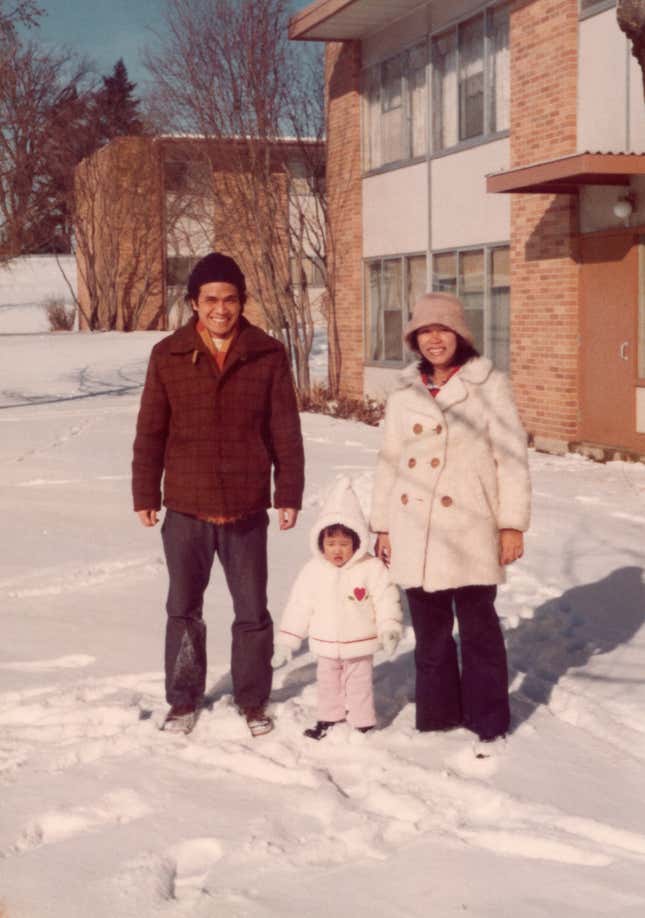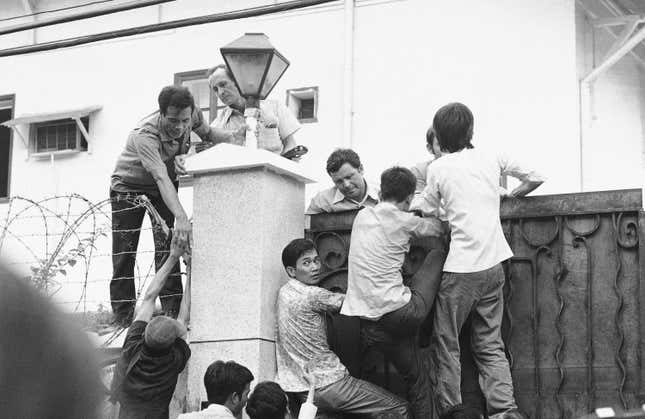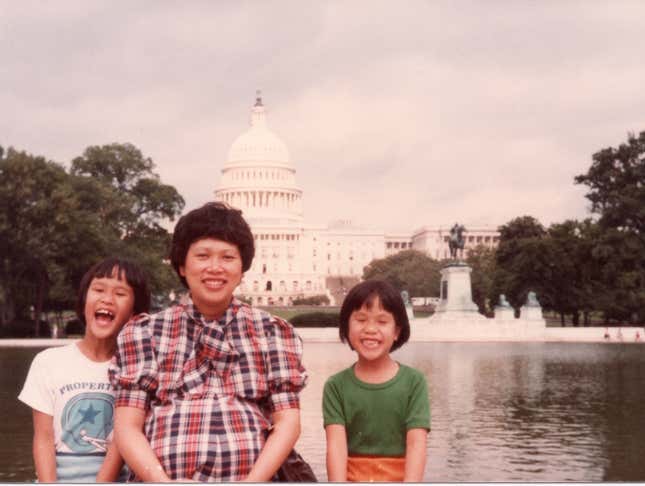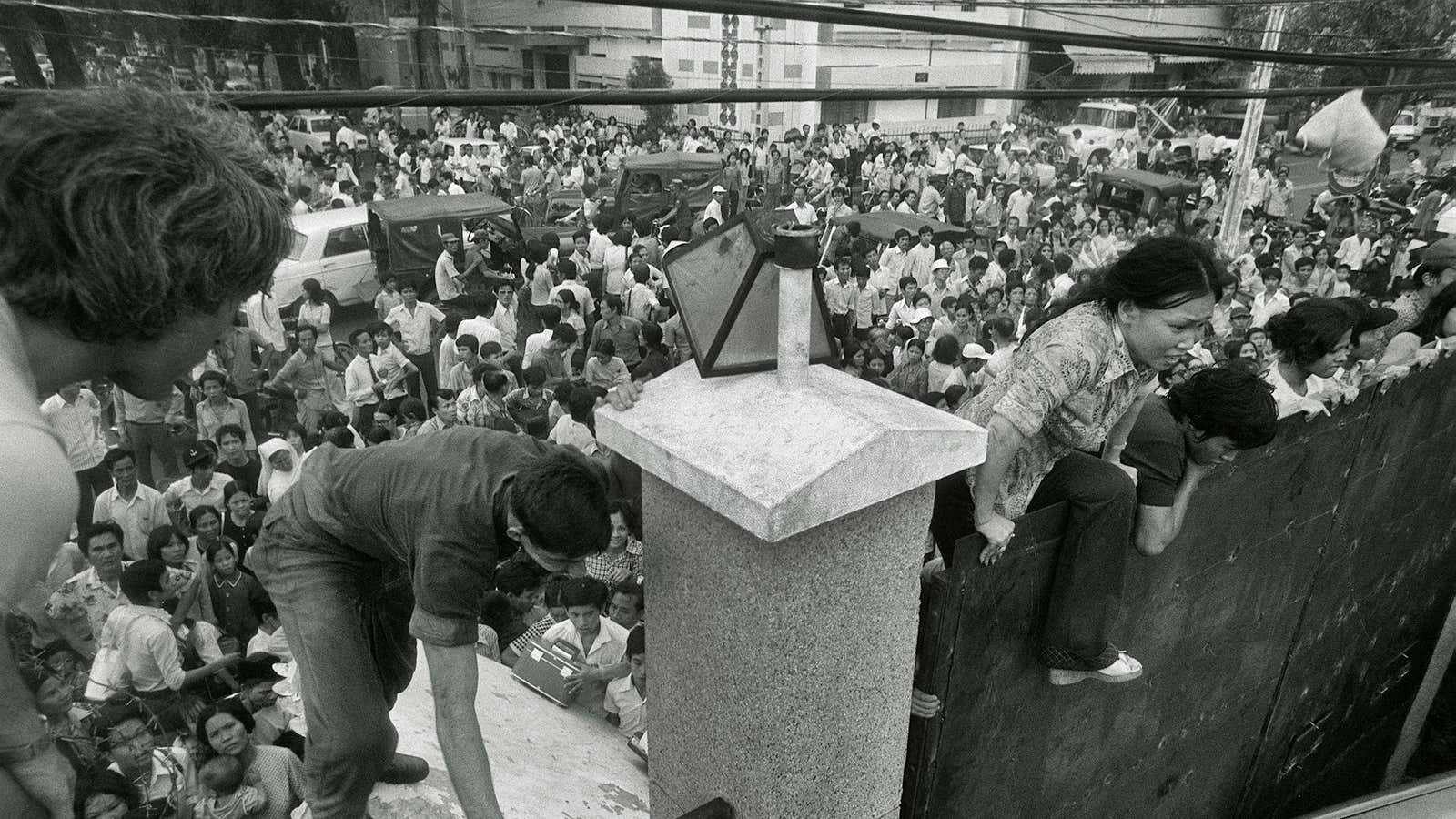Any number of things could have gone wrong.
It was March 1975, and my father had been in the US for 10 months. He had a scholarship to get his master’s in applied math at then University of Missouri-Rolla, but he found it impossible to focus. The war at home in Vietnam was getting worse, and his wife and 10-month-old daughter—my older sister—risked being stranded in Saigon. My father knew that, barring some miracle, he would be separated from them, maybe for years, possibly forever.
James and Shirley Clifton had met my father once. Their son Jim was my father’s friend and classmate, and had invited him to dinner at their house in St. Louis, Missouri the previous Christmas. Though my mother was a total stranger to them, the Cliftons agreed to sign an affidavit of support—a promise to take financial responsibility—for her and her daughter. My father had no degree of certainty that it would work, but he accepted all the same.

Four days before the end of the American Vietnam War on April 30, 1975, my mother and sister were swept into a military cargo aircraft leaving from Tan Son Nhat Airport in Saigon (now Ho Chi Minh City). Along with thousands of others fleeing the country, she spent weeks in refugee camps in the Philippines and Guam before arriving in Arkansas. Eventually she reached a new home in Madison, Wisconsin, where she saw snow for the first time. She would go on to work as a material analyst and systems engineer for 34 years, and have four children who would grow up to go to college, become engineers, designers, and writers, buy cars and homes, and themselves have three children.
Today the 1.3 million immigrants from Vietnam and their 300,000 or so children, along with their culture and cuisine, are just one more inextricable strand of the American fabric. But it’s worth remembering that this wasn’t always a given. Back in the 1970s, the American public’s opposition to letting in Vietnamese refugees was even higher than today’s opposition to Syrian asylum-seekers, both in the US and in much of Europe.
Between us
In late April 1975, the Viet Cong had taken over Da Nang and were closing in on Saigon. People who had been living in anti-Communist South Vietnam since the country split in 1955 were deathly afraid of the northern invasion. In the 1950s, landowners in the Communist north had been forced from their homes and publicly executed as a form of class retribution. It’s estimated that at least 15,000 people were killed or died in prison during the so-called “land reforms,” though some put those numbers much higher.
When it was clear that the south and the US would lose the war, wealthy southerners feared history would repeat itself, and were desperate to escape. Anyone who was married to an American, had helped the American forces, or had family living in the US would likely be among the first victims of the new regime. As the US prepared to pull out its forces, its leadership felt a moral imperative to help them.
But the American public didn’t share the feeling.
In 1975, when a first wave of refugees fled after the fall of South Vietnam, polls showed support for welcoming them into the US at 37% for and 49% against, with 14% uncertain. In the late 1970s, a second, larger group of migrants, the “boat people,” traversed dangerous waters to leave Vietnam. They paid exorbitant fees and risked abduction, rape, and death at sea to escape the reeducation camps that had sprung up after the northern victory over the south.
In 1979 US president Jimmy Carter announced he would double the number of refugees from Vietnam, Cambodia, and Laos accepted into the United States from 7,000 per month to 14,000. A poll from CBS and The New York Times showed that 62% of Americans disapproved. He did it anyway.
Today, despite the xenophobic and anti-Muslim rhetoric from Republicans in the US presidential primaries, Americans are still less hostile to Syrian refugees than they were in 1979 to Southeast Asians. A slew of polls late last year found that opposition to letting Syrians in ranged between 50% and 60%.
In Europe, which is bearing the brunt of the refugee crisis, attitudes have been hardening in recent months. But even so, only two in five Brits polled in January said the country should be accepting fewer refugees than it currently does—and Britain was one of the least welcoming countries in Europe, according to another poll. In Germany, despite a backlash against her open-door refugee policies, chancellor Angela Merkel still enjoyed a 54% approval rating (paywall) in March.

Operation: get out
Despite the pro-refugee stance of the US government, families who were able to leave before the fall of Saigon often got out only with a considerable amount of luck and cajoling.
Six days before the Viet Cong invaded Saigon, my father’s older sister, Tran Di, stood for hours at the office of the US embassy’s defense attaché. Thirty-seven years old, with three children of her own under 13, she was clutching papers for a total of 12 family members, including my mother. She wheedled and begged the American behind the desk to approve her request to let them leave the city. He turned her down.
But there was another line—and it was moving much more quickly. She joined it. The American she spoke to there seemed more easygoing. He pointed to her form, asking how her husband would support all those family members on $1,000 a month; she told him she would work, too. He asked why she had another family’s papers. She told him that if her brother—my father—never saw his baby again, it would be on his head.
“God bless you!” he said, and stamped my mother’s papers.

In a relatively short time, Vietnamese immigrants and their offspring not only made America home, but climbed the economic ladder.
The nonprofit think tank Migration Policy Institute estimates that in 2012 Vietnamese immigrant households had a median income of $55,736—higher than that of the immigrant population at large (about $47,000) as well as of US-born households (about $52,000). Pew estimates that 19% of Vietnamese-Americans hold a bachelor’s degree—on par with the general population’s 18%. They are also optimistic: In 2012, 83% of Vietnamese-Americans told Pew most people can succeed in life with hard work, as against just 58% of the general population.
In 1995 the US and Vietnam reestablished diplomatic relations. Vietnamese food and culture have become ubiquitous. Pho and banh mi are staples of hipster life in LA, Seattle, Houston, and New York. Travel to Vietnam is practically a cliché. The now iconic Huy Fong Sriracha sauce, the brainchild of Vietnamese immigrant David Tran, is a worldwide phenomenon.
Of course, today’s refugee crisis is very different from the southeast Asian migration of the 1970s. There are far more countries, causes, and powers involved today, and the nearly 5 million (and counting) Syrian refugees alone far outnumber the 1.3 million who left Vietnam.
All the same, as Greece turns away Syrian migrants, its Balkan neighbors close their borders, and thousands of asylum-seekers die at sea, it’s worth remembering that decades ago, despite widespread public opposition and xenophobia, a country opened its doors to those seeking safe, dry land. And they, in turn, left a lasting mark on a new home.
